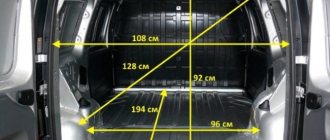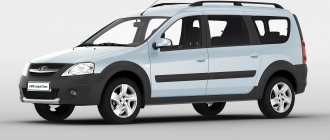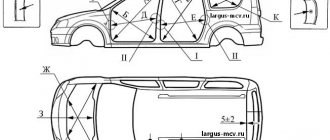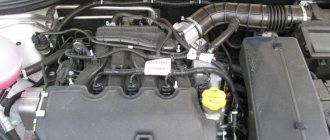In 2012, the domestic car market was replenished with a new universal model Lada Largus. This product from AvtoVAZ immediately fell in love with a wide mass of fans who value unpretentiousness and practicality in a car. Two years earlier, the prototype was first presented to the general public, and the cargo van version was positioned as a commercial option.
When compared with foreign analogues, the Russian station wagon has a significant advantage – a lower price. According to the manufacturer, the quality indicators of the Lada Largus can compete on equal terms with the advantages of such popular foreign cars as Citroen Berlingo or Renault Kangoo in cargo version.
Features of the Largus Van model
Although this utility vehicle is produced at the AvtoVAZ enterprise and is endowed with Lada emblems, it was developed jointly with the Renault concern, in a sense it can also be considered a French (Romanian) brand. Since 2012, the model has been produced without restyling and any global modernization, unless you take into account the changed range of engines and the appearance of a modification with gas equipment (LPG).
The Largus Van is equipped with only one row of seats and has an impressive cargo compartment with three doors (two side doors and a rear double door), which ensures convenient loading and unloading of transported goods or things. There is a removable partition between the passenger cabin and the cargo compartment; there are no side trims inside the van (only painted metal).
The rear swing doors of the body can be fixed in three positions - at opening angles of 40, 90 and 180 degrees , the side doors here open wide. In all configurations, except the simplest one, a polyethylene floor mat is provided in the cargo compartment; the van also has a backlight and six mounting loops for securing luggage. The cargo compartment is characterized by a flat floor, no thresholds, and a fairly low and therefore comfortable loading height.
Cargo bay exterior
The exterior of the station wagon turned out to be classic and discreet in terms of design. This is characterized by the desire of the developers to adapt the body as much as possible to business conditions, making it the most serious and calm. All exterior elements are thought out to the smallest detail. For such rigor, the Lada Largus in cargo version attracted not only representatives of the transport business, but also summer residents.
The car model, which was created in 2022, can first of all be compared with its station wagon brother, and the differences in body shape will be obvious:
- A rather practical solution in commercial terms is to paint the side mirrors and bumper of the car in black, and not in the main tone of the car, because when transporting cargo along country roads, there are often cases of dents and scratches that remain almost invisible against a dark background.
- The car is equipped with rear blind doors without glass. This design reduces the likelihood of damage to the surface of the transported cargo, even when driving on uneven roads.
Despite the large size of the cargo compartment of the Lada-Largus van, the car looks compact in appearance, which is a winning advantage.
Largus Van interior
The interior of the cargo-passenger Largus is designed to seat two people (driver and one passenger) and is equipped with seats with mechanical adjustment in four directions. What else can be noted in the car interior:
- the steering column is adjustable, but only in height;
- the chairs are generally comfortable, but with insufficiently rigid backrests;
- the ceiling in the cabin is high, there is more than enough headroom;
- the instrument cluster has speedometer and tachometer dials on the sides, a small monochrome display occupies the middle position;
- almost all control elements (keys for power windows, central locking, emergency lights, handles for air conditioning and heating systems) are located centrally on the dashboard or on the center console, there is also a 12-volt socket;
- steering wheel - three-spoke, without keys;
- there is no interior mirror;
- The interior door panels are made of hard plastic.
The seat heating buttons are installed on the sides of the seats themselves, on the door side, but in the poorest configuration they will not be there, as well as the ESP buttons. The air ducts on the dashboard are round in shape; in appearance they resemble deflectors from a Gazelle.
Unfasten the partition or part of it
The partition separating the body and the cabin consists of two halves. They can be removed separately. Both parts are screwed to the body with screws designed for a 13mm key size. Of course, you need a socket wrench.
Screws 1 were hidden under the casing
The four screws on the left and right are located on the cab side. And to unscrew them, remove the casing.
All actions with cladding
The left part of the septum is removed after the right. To remove only the left half, first remove both, and then mount the right sash back. Based on this, immediately decide where you will remove the trim - only on the right or on both sides.
The volume of the body on the Lada Largus van cannot be greatly increased, even if the partition is completely removed. But without the partition, by removing the seat, it will be possible to transport loads 3 meters long.
So, let's start dismantling the trim: you need to remove the seat belt (key “17”), and then unscrew one self-tapping screw. A Torx T20 wrench is suitable for the self-tapping screw.
Two parts “1” prevent the removal of casing “2”
It is necessary to unscrew all the parts numbered 1. And the casing will have to be removed, overcoming the resistance of the clamps.
Removing the partition
First, unscrew the four screws shown at the beginning of the chapter (key “13”). Then with the same key they go into the body.
All fasteners are the same
As you can see, both halves are held on three sides: top, bottom, middle. The number of screws will be as follows: four at the top and bottom, five at the seam between the sashes. Work order:
- Completely unscrew the four screws on top;
- While holding the nuts on the seam, unscrew the screws from the cabin side;
- The lower screws are unscrewed 2-3 turns. Then all parts are disengaged.
Let us remind you that the right wing can be removed separately. We wish you success.
Engines and transmission
From the very beginning of production, the Largus F90 was equipped with two 1.6 liter gasoline engines from the French company Renault with the indices K7M (8-cl., 84 hp) and K4M (16-cl., 105 hp), but in Later, these engines were replaced by domestically produced engines. The K7M was replaced in 2015 by the eight-valve internal combustion engine VAZ-11189, and in 2017, instead of the K4M, the car received a sixteen-valve VAZ-21129.
All Largus Van variants have a manual transmission (5 steps), provided by French developers; manual transmission models are JR5 and JH3. The VAZ-11189 brand is an in-line four-cylinder engine with a volume of 1596 cc. cm , 8-valve, has the following data:
- max power - 87 hp. With. ;
- fuel system type - injector;
- torque max - 140 N*m ;
- timing drive - belt type;
- compression ratio - 10,5;
- compliance with environmental standards - Euro-5;
- Recommended fuel is AI-92 gasoline.
The engine of model 11189 allows Largus to accelerate to 158 km/h and reach a hundred in 15.4 seconds . Average fuel consumption per 100 km with an 8-valve VAZ engine, according to the automaker, is 8.2 liters , gasoline consumption in the city and on the highway is 10.6 and 6.7 liters , respectively.
The 21129 gasoline engine was launched into production in 2015 , originally intended for the Vesta and Xray car series. The engine has been installed on Largus since October 2017 ; it also meets the requirements of Euro-5 environmental standards. Characteristics of this internal combustion engine:
- volume - 1596 cubic meters. cm ;
- max power - 106 hp. With. ;
- torque max - 148 N*m ;
- valves per cylinder - 4;
- gas distribution mechanism drive - belt;
- compression ratio - 10,5;
- type of fuel system - injector.
Engine 21129 also easily “digests” 92-octane gasoline and provides the F90 van with acceleration to “hundreds” in 14 seconds , with a maximum speed of 165 km per hour . The fuel consumption of a utility vehicle per 100 km with a sixteen-valve VAZ engine in highway/city/average modes is 6.4/10.4/7.7 liters , respectively.
"Insides" of the car
The Lada-Largus van is equipped with the same gasoline engines as the station wagon of the same name - these are in-line fours with a displacement of 1.6 liters:
- 8-valve engine that is capable of developing 87 hp. With. at 5100 rpm.
- 16-valve engine with a potential of 106 hp. With. at 5800 rpm.
As standard, the car is equipped with a 5-speed manual transmission and a front-wheel drive transmission. From 0 to 100 km/h the Lada-Largus van picks up speed in 14-15.4 seconds to 158-165 km/h. In the combined cycle, the car “eats” 7.9-8.2 liters of fuel for every hundred kilometers.
The van is built on the front-wheel drive B0 platform. The actual size of the body of the Lada-Largus van and the dimensions of the entire structure make the car practical and at the same time visually compact.
Specifications
The Lada Largus Van model is a light commercial vehicle with a van body, designed to transport cargo weighing up to 725 kg . The vehicle is also capable of additionally towing a trailer weighing up to 650 kilograms , and if the trailer is equipped with brakes, its weight can be increased to 1300 kg . Other technical characteristics of the machine:
- two seats in the cabin ;
- number of doors - five (rear door - double-leaf);
- van volume (cargo compartment) - 2540 l ( 2225 l for the gas version);
- gas tank capacity - 50 l ;
- length/height/width of the car - 4.47/1.65/1.75 m ;
- wheelbase - 2905 mm ;
- front wheel track - 1469 mm (for the rear axle - 1466 mm );
- ground clearance - 145 mm ;
- curb weight - 1260 kg (for the version with LPG - 1380 kg );
- total weight - 1985 kg ;
- The minimum turning diameter is 11.25 m .
Largus Van is equipped with MacPherson front suspension, a beam is installed at the rear, and factory tire sizes are 185/65R15 . The brakes on the car are discs in the front and drums in the rear, the wheel drive is front-wheel drive in all versions. In any configuration, Largus Van is equipped with stamped 15X6J wheel disks, and a mechanical parking brake is installed on the vehicle.
Read also: Suzuki Jimny - the “little prince” of the world’s roads
Trunk dimensions (2104, 2111, Kalina, Niva 5D, Shniva, Largus)
It was interesting, I decided to Google it. Perhaps it will be useful to someone...
Opening height: 75cm Opening width (maximum): 110cm Length: 150cm (without rear seat)
Opening height: 89cm Opening width: 107cm Length (min): 103cm Length (max): 163cm
Opening height: 80cm Opening width: 96cm Length (min): 78.5cm Length (max): 143cm
Opening height: 89cm Opening width: - Length (min): 85cm Length (max): 132cm
Opening height: 93cm Opening width: - Length (min): 68cm Length (max): 123cm
Opening height: 92cm Opening width: 100cm Length (min): 99cm Length (max): 166cm
Also, do not forget that the back row can be dismantled in principle (as is the case with 2104 in the 1st photo) and then there will be more space :) And also, fold out the front passenger seat)
And for fun (fun) again: 2111: Opening height: 89cm Opening width: 107cm Length (min): 103cm Length (max): 163cm
Lada Largus: Opening height: 92cm Opening width: 100cm Length (min): 99cm Length (max): 166cm
And you yourself know the prices for these cars))











